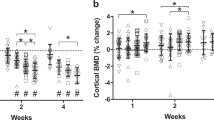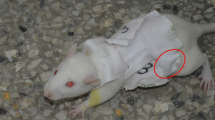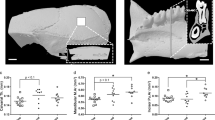Summary
Juvenile laboratory mice were exposed to hypergravity (8 g), burrowing exercise, swimming to exhaustion, an anabolic steroid, and swimming and an anabolic steroid for 30 days to determine the variability of skeletal mineralization during growth. Changes in mineralization were correlated with changes in bending strength. Experimental mouse femora were loaded to failure in a cantilever beam configuration to determine bending strength, and ashed to determine total mineral content. Between experimental groups, mineral content ranged from 66.0 to 71.2% with the greatest change from the control being a 4.7% decrease in mineralization in the male swimming exercise group (P<0.001). Within two age-matched experiments, the first showed that the group with the greatest decrease in mineralization also had the greatest reduction in bending strength (P<0.001). The second age-matched experiment showed that the group with the greatest reduction in mineralization had bending strength greatly reduced (P<0.001). However, in this experiment, the weakest femora were in the anabolic steroid group that did not have the mineral content reduced. We conclude that (1) mineralization of juvenile mouse femora is extremely variable given varied conditions of exercise or loading; (2) mineralization of normal bone is decreased more often and to a greater extent than increased from normal exercise controls; (3) the decrease in mineralization seen here can decrease bending strength; and (4) the decrease in mineralization seen was not caused by a decrease in mechanical loading but was probably due to a corticosterone-mediated psychological stress response. Therefore, two variables were indicated, one anabolic (mechanical loading) and one catabolic (corticosterone).
Similar content being viewed by others
References
Curry J (1975) The effects of strain rate, reconstruction and mineral content on some mechanical properties of bovine bone. J Biomechanics 8:81–86
Currey J (1984) Comparative mechanical properties and histology of bone. Amer Zool 24:5–12
Currey J (1984) The mechanical adaptations of bones. Princeton University Press, Princeton Guildford p 90
Dalen NH, Hellstrom L, Jacobson B (1976) Bone mineral content and mechanical strength. Acta Orthop Scand 47:503–508
Kusy RP, Peng T, Hirsch PF, Garner SC (1987) Interactions of bone ash and whole bone properties in the lactating and parous rat. Calcif Tissue Int 41:337–341
Smith CB, Smith DA (1976) Relations between age, mineral density and mechanical properties of human femoral compacta. Acta Orthop Scand 47:496–502
Ashman RB (1989) Experimental techniques. In: Cowin SC (ed) Bone mechanics. CRC Press, Boca Raton FL, p 78
Dalen N, Olsson KE (1974) Bone mineral content and physical activity. Acta Orthop Scand 45:170–174
McDonald R, Hegenauer J, Saltman P (1986) Age-related differences in the bone mineralization of rats following exercise. J Gerontology 4:445–452
Ringe J-D, Steinhagen-Thiessen E (1985) Prevention of physiological age-dependent bone atrophy by controlled exercise in mice. Age 2:44–47
Donaldson CH, Hulley SB, Vogel JM, Hattner RS, Bays JH, McMillian DE (1970) Effect of prolonged bedrest on bone mineral. Metabolism 19:1071–1084
Niklowitz WJ, Bunch TE, Young DR (1983) The effects of immobilization on cortical bone in monkeys (M. nemestrina). Physiologist 26:S115–116
Verhas M, Martinello Y, Mone M, Heilporn A, Bergmann P, Tricot A, Schoutens A (1980) Demineralization and pathological physiology of the skeleton in paraplegic rats. Calcif Tissue Int 30:83–90
Spector M, Turner RT, Morey-Holton E, Baylink DJ, Bell NH (1983) Arrested bone formation during space flight results in a hypomineralized skeletal defect. Physiologist 26:S110–111
Simmons DJ, Russell JE, Grynpas MD (1986) Bone maturation and quality of bone material in rats flown on the space shuttle “Spacelab-3 Mission”. Bone Miner 1:485–493
Simmons DJ, Grynpas MD, Rosenberg GD (1990) Maturation of bone and dentin matrices in rats flown on the Soviet Biosatellite Cosmos 1987. FASEB J 4:29–33
Simkin A, Ayalon J, Leichter I (1987) Increased trabecular bone density due to bone loading exercises in postmenopausal osteoporotic women. Calcif Tissue Int 40:59–63
Simon MR, Holmes KR, Olsen AM (1984) The effects of simulated increases in body weight for 60 days on robusticity and mineral content of limb bones of hypophysectomized rats. Anat Rec 210:333–341
Gordon KR, Reese SR, Knecht PA (1989) Changes in the architecture of cancellous bone in the femora of developing mice as a result of short duration hypergravity. Amer Zool 29:205–219
Gordon KR, Perl M, Levy C (1989) Structural alterations and breaking strength of mouse femora exposed to three activity regimens. Bone 10:303–312
Hill AJ, Sachs JR, Brigham C (1983) The athletic polydrug abuse phenomena. Am J Sports Med 11:269–271
Ding J, Sheckter CB, Drinkwater BL, Soules MR, Bremmer WJ (1988) High serum cortisol levels in exercise-associated amenorrhea. Ann Int Med 108:530–534
Frost HM, Villanueva AR III (1961) The effect of cortisone on lamellar osteoblastic activity. In: Human osteoblastic activity. Henry Ford Hosp Med Bull 9(1 pt II):97–99
Stanisovljevic S, Roth H, Villanueva AR, Frost HM (1962) Effect of adrenal corticoids on lamellar bone formation rate in rat diaphysis. Henry Ford Hosp Med Bull 10:179–184
Storey E (1963) The influence of adrenal cortical hormones on bone formation and resorption. Clin Orthop Rel Res 30:197–216
Jee WSS, Park HZ, Roberts WE, Kenner GH (1970) Corticosteroid and bone. Am J Anat 129:477–480
Reid IR (1989) Steroid osteoporosis. Calcif Tissue Int 45:63–67
Hofmann FG (1956) Observations on in vitro adrenal steroid synthesis in the albino mouse. Endocrinology 59:712–715
Howard E (1962) Steroids and bone maturation in infant mice: relative activities of dehydroepiandrosterone and testosterone. Endocrinology 70:131–141
Silbermann M, Bar-Shira-Maymon B, Coleman R, Reznick A, Weisman Y, Steiphagen-Thiessen E, von der Mark H, von der Mark K (1990) Long-term physical exercise retards trabecular bone loss in lumbar vertebrae of aging female mice. Calcif Tissue Int 46:80–93
C-Rodriguez E, Gordon KR (1990) Effects of psychological stress on growth and strength of mouse femora. Amer Zool 30:76A
Author information
Authors and Affiliations
Rights and permissions
About this article
Cite this article
Gordon, K.R., Burns, P. & Keller, G. Experimental changes in mineral content of juvenile mouse femora. Calcif Tissue Int 51, 229–232 (1992). https://doi.org/10.1007/BF00334552
Received:
Revised:
Issue Date:
DOI: https://doi.org/10.1007/BF00334552




